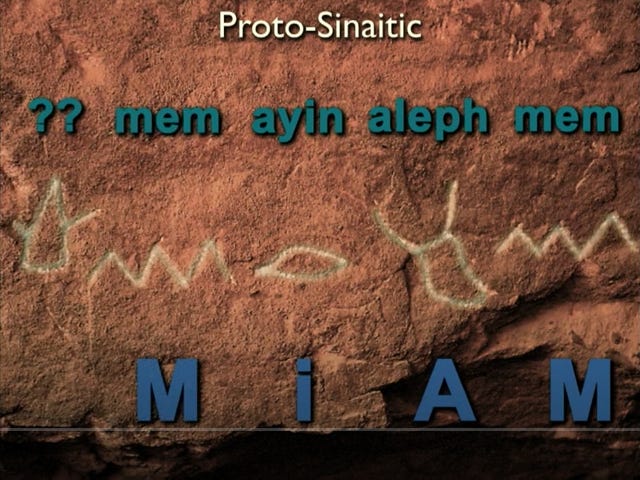JOSEPH INVENTED THE ALPHABET?
Joseph could read and write the Egyptian hieroglyphs, but also being a Semite, he apparently used them to make a new alphabet. At Serabit el-Khadim is the main turquoise mine of Egypt in the SW Sinai peninsula. On the top of the mountain is a temple of Hathor (called the lady of turquoise). Semites/Hebrews were sent there, apparently by Joseph, to mine turquoise near the temple.
Petrie found in the mine an unfamiliar script. Alan Gardiner came along later and saw that it was Hebrew, written in hieroglyphs, called proto-Sinaitic. Joseph apparently invented that, which was modified by the Phoenicians, modified again by the Greeks and then by the Romans to make the modern alphabet. Above is Proto-Sinaitic letters that spell the Hebrew word Maim or Mayim, reading from right to left, meaning water. The symbol on the far left indicates a leather water bag.
Sumerian Cuneiform and Egyptian Hieroglyphics were first used possibly c. 3000 BC, but Joseph’s alphabet was apparently the first writing system using letters to represent the sounds of speech.
ENSLAVEMENT OF THE HEBREWS
When Moses was born, the Egyptians are said to have begun killing Hebrew male infants. Where the Hebrews lived at Avaris in the eastern Nile delta, there were many more infant burials than normal, indicating evidence of the killing of male infants.
A scribe under the Ptolemies said the pharaoh at the time of Moses was Khe-noph-res, or Khe-nefer-re. Kheneferre Sobekhotep IV was the 29th ruler of the 13th dynasty of Egypt.
Kheneferre probably had a summer palace at Avaris like the above. And Moses was likely raised there.
The white buildings above are in the Egyptian section of Avaris.
Above are fragments of a papyrus showing the pharaohs who enslaved the Hebrews. Kheneferre is the last one on the list. That’s Moses’ step-father.
Above is a wider view of the papyrus. Reading right to left, Kheneferre is at bottom right, then in the next column to the left is a list of later kings. There were 11 kings after Moses’ step-father by the time of the Exodus. The last of those kings was named Tutimaos or Dudimose. Velikovsky figured out in 1950 or so, that Tutimaos was the pharaoh of the Exodus, but other evidence has since helped confirm that.
Above is what the Egyptian priest, Manetho under the Ptolemies, said about the conditions after the Hebrew Exodus from Egypt. Rohl opined that it describes their punishment for having mistreated the Hebrews. The Hyksos were able to conquer Egypt without resistance, because the pharaoh’s army had by then drowned in the Red or Reed Sea.
Above are the bodies at Avaris of some who died from plague and were buried hastily, apparently Egyptians who died from one of the ten plagues.
Avaris was then abandoned for a few years until the Hyksos built a mortuary on the site for the Hyksos kings.
CONQUEST OF CANAAN
I’ll try to cover the Exodus in the next post. But I’ll skip past that for now to show evidence for the Hebrew conquest of Canaan. Above is the first Canaanite city destroyed, Jericho, across the Jordan River.
After the walls of Jericho came down, the city was burned and above is a grain storage jar full of burned grain. It was full because the grain had just been harvested and it was not yet used, as winter had not yet arrived. It also suggests that the siege was brief. The Bible says it lasted 7 days.
Hazor was the second city destroyed (above). A letter found at the site even had the name of the king that Joshua killed, as stated in the Bible. The yellow square on the left shows where the letter was found and the letter is shown on the right.
Another city the Hebrews destroyed in Canaan was Shechem. Joshua had a standing stone erected there. Archeologists found it and re-erected it as shown in the image at left in the yellow circle. I think the Hebrews then built a temple near the stone that looked like the image on the right. The inset shows what the stone looks like.
Above is a Bible passage that discusses the stone.
The temple was called Migdol Shechem and it was attacked about 100 years later apparently by Philistine King Abimelech, who had the temple burned, as described in the Bible passage above.
So the Bible story of Joseph and the Sojourn in Egypt till the Exodus is found to be largely confirmed by archeology, once the evidence is looked for in the right time dynasties, as shown above. Joseph came to power about 1650. The Hebrews prospered for a century or so. Then they were enslaved for some decades. Then the Exodus occurred about 1450 BC. After they wandered for 40 years, they conquered Canaan about 1410 BC.
I plan to present evidence for the Exodus next.






















